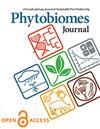Host and Fusarium-adapted bacterial consortia alter microbial community structures in Arabidopsis roots and suppress Fusarium oxysporum
IF 2.6
3区 生物学
Q2 MICROBIOLOGY
引用次数: 0
Abstract
The plant-associated microbiota confers beneficial traits to the plant host by promoting growth and preventing disease. It is, however, not fully understood how the host and the associated microbiota interact with pathogens. In this work, we studied how the host plant modulates its associated microbiome to suppress disease. For this, we used two Arabidopsis thaliana lines with different host responses to Fusarium oxysporum f. sp. mathioli (FOM). We isolated bacterial consortia (BCs) from FOM-infected or healthy host plants of the two lines of Arabidopsis and studied their effect on the root-associated microbiota and FOM progression in the following generations of Arabidopsis plants. Root bacterial and fungal communities were profiled using 16S rRNA and ITS amplicon sequencing, respectively, while qPCR was used for assessment of FOM quantities in shoots of Arabidopsis. Host- or pathogen-adapted BCs significantly reduced FOM quantities in shoots of both the resistant Col-0 and the susceptible Ler-0 Arabidopsis lines. Several bacterial taxa including Chthoniobacter, Bacillus, Chryseobacterium and Actinoplanes negatively correlated with FOM suggestive of an antagonistic effect. Furthermore, both host- and pathogen-adapted BCs significantly affected community composition with distinct differentially abundant taxa and co-cooccurrence network structures. Taken together, our findings suggest that using a subcommunity selection approach is a potential route for exploiting plant associated rhizosphere microbiomes for engineering disease resilient microbiomes.宿主和镰刀菌适应细菌群落改变拟南芥根中的微生物群落结构并抑制尖孢镰刀菌
植物相关微生物群通过促进生长和预防疾病,赋予植物寄主有益的性状。然而,目前还不完全清楚宿主和相关微生物群如何与病原体相互作用。在这项工作中,我们研究了寄主植物如何调节其相关微生物组来抑制疾病。为此,我们选用了两个对镰刀菌(Fusarium oxysporum f. sp. mathioli, FOM)有不同寄主反应的拟南芥品系。我们从感染了FOM的两个品系或健康的拟南芥寄主植株中分离出细菌联合体(bc),并研究了它们对拟南芥后代根系相关微生物群和FOM进展的影响。采用16S rRNA和ITS扩增子测序技术分别对拟南芥根系细菌和真菌群落进行了分析,采用qPCR技术对拟南芥芽部FOM数量进行了评估。宿主或病原体适应的bc显著降低了抗性col0和敏感的Ler-0拟南芥品系的芽部FOM数量。几个细菌分类群,包括硫杆菌、芽孢杆菌、黄杆菌和放线素菌群,与FOM呈负相关,提示其拮抗作用。此外,宿主适应性和病原体适应性bc对群落组成都有显著影响,类群丰富度和共生网络结构差异显著。综上所述,我们的研究结果表明,使用亚群落选择方法是利用植物相关根际微生物组来设计抗病微生物组的潜在途径。
本文章由计算机程序翻译,如有差异,请以英文原文为准。
求助全文
约1分钟内获得全文
求助全文

 求助内容:
求助内容: 应助结果提醒方式:
应助结果提醒方式:


